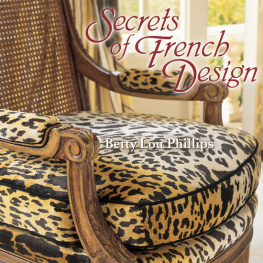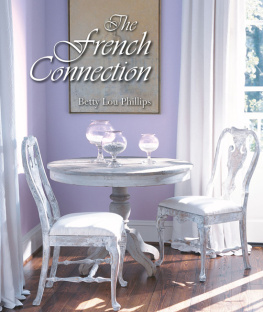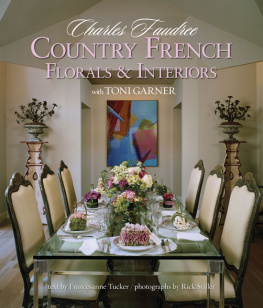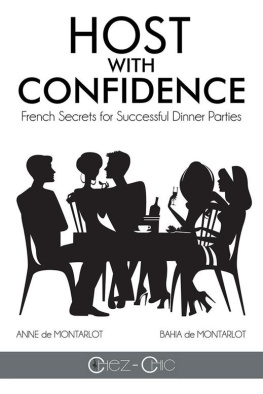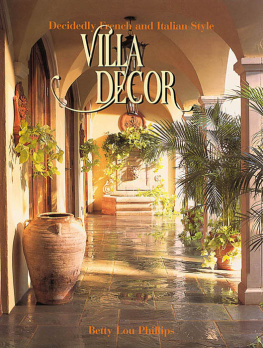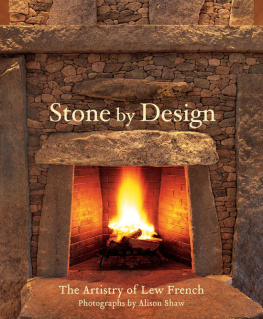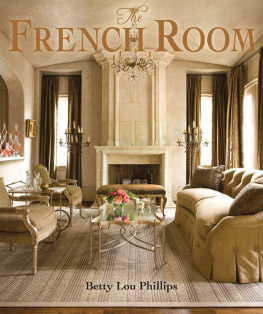All rights reserved. No part of this book may be reproduced by any means whatsoever without written permission from the publisher, except brief portions quoted for purpose of review.
On the Cover: A silk velvet from the renowned fabric house Scalamandr sprawls across a Louis XVIstyle chair by Nancy Corzine. Reportedly, Daisy Fellowes (18871962), one of the most glamorous socialites of the time, deserves credit for being the first to recognize the leopard fabrics exotic allure. She used it to cover a sofa. The Scalamandr yellow-and-brown stripe on curtains also merits high praise.
Introduction
Given their strong sense of self, commanding flair, and ardor for collecting, to say nothing of their savoir-faire, the French simply do not understand American dependence on decorators, which they view as leaving one vulnerable to uncertain results.
Its not that none would ever dream of collaborating with a design professional, only that most would never turn over control of a project even to the most capable hands. Never mind that ancestral furniture and objets dart conspire to make seeking expert help unnecessary. Most see decorating as an aesthetic undertaking en route to self-satisfaction.
Faced with myriad issues that warrant assistance, the French are likely to have a comprehensive plan, opt to be hands-on, and be exacting in requestsspecifying styles, shapes, and proportions in such detail that their wishes leave little doubt.
Yet armed with educated eyes, unerring taste, and amazing confidence, the majority buy what they like, upholding the standards they insist upon while painting flattering self-portraits revealing their passions, interests, and heritagewhich is, of course, their intention.
Without fail, settings start with furnishings handed down from one generation to the next. As rooms take shape, they gather even more accoutrements that are meaningful. Determined to prevent their national symbols from fleeing to cities far outside France, habitus flock to the Htel Drouot, in Pariss ninth arrondissement (district), where three thousand auctions held annually teem with temptations for every predilection.
In addition, they spend weekends relentlessly combing the famous March aux Puces de Saint-Ouen, the vast flea market on the outskirts of the capital in existence since 1886, as well as les puces (flea markets) at Vanves and Montreuil, unless traipsing to LIsle-sur-la-Sorgue, the Lubrons matchless center for antiques, with more than 250 brocanteurs (dealers).
Even so, most interiors are neither cluttered nor intimidating. Despite the grandeur in which Louis XIV resided in the magnificent Palace of Versailles, understated glamour is a design dictum. The French equate elegance with restraint, shunning the Baroque lifestyle identified with the Sun Kings reign (16431715).
Not that there arent touches of glamour inside appartements in the Ile-de-Francethe very heart of France, including Paris and surrounding seven dpartements . Eleven million people live in this historic region. By some estimates, less than twenty-five percent dwell in single family homes.
As it turns out, most apartments are modest in size by American standards, in spite of lofty ceilings, deep chiseled moldings, patterned wood floors, and untold presence. The older the building, in general, the more prestigious it is. Yet, as if a breach of good taste, this is not something residents talk about anymore than those who live behind the heavily lacquered doors leading to eighteenth-and-nineteenth-century htels particuliers now divided into apartmentspoint out that they inhabit the most elegant of all privately owned domains.
Amid the intimacy that classically proportioned rooms afford, unabashedly swirl shimmering taffetas, sophisticated jacquards, smart damasks, and chic chairs from the beguiling rococo period (173060) when Louis XV and his renowned mistress, Madame de Pompadour, had great influence on the decorative arts.
And, there is, indeed, nothing conservative about blurry centuries-old mirrors, valued Aubusson carpets, stone busts, and furniture in the style of Louis XVI (176089), even if clean-lined neoclassicism developed as a reaction against the perceived excesses of rococo styleabout which there is no doubt.
Mixing periods is, of course, common practice, easing formality. But playful leopard fabric may also sweep away the seriousness of a space by making the glamorous appear more relaxed, or vice versa. Certainly, looks vary. Seldom do the French stray from their unified approach to decorating, however.
Whether furnishing an appartement on Pariss grand avenue Foch, a chteau in the Loire Valley, or a bastide just outside the village of St-Rmy-de-Provence, the French make no secret of their love for family, affection for pets, and fervor for France. But the old-world lan of their rooms may well owe even more to unspoken revelations equally instinctive.
With the wisdom gleaned from fervent beliefs that have long defined French decorating, savvy Americansdesigners and notartfully sculpt satisfying rooms that closely mirror their personalities and the lives they lead.
So what, then, do the French think of the living spaces showcaseddrawing on American roots yet owing more than a little to their influence? Cest impossible to say. However, we trust that they approve. How could they not? How indeed?
Yet with mystery rooted in the French culture, it is only fitting, perhaps, that their feelings should remain a lasting secret.
Betty Lou Phillips, ASID
Interior Stylist

A handsome hood deserves the spotlight. Each piece of tumbled and pillowed Italian marblethe white is Carrera; the black Negrois one inch square. The stainless-steel range is by Wolf.

A toile from Lee Jofa wraps a room and a nineteenth-century iron daybed in understated beauty. At the time, horsehair or wadded cotton would have filled the cushion. Here, delft vases circa 1830 rest on English hand-carved wall brackets from Jas A. Gundry, Inc., Houston. Hovering over the bed are Minton, Canova, and Dresden patterned plates, soup bowls, and plattersall equally alluring.

